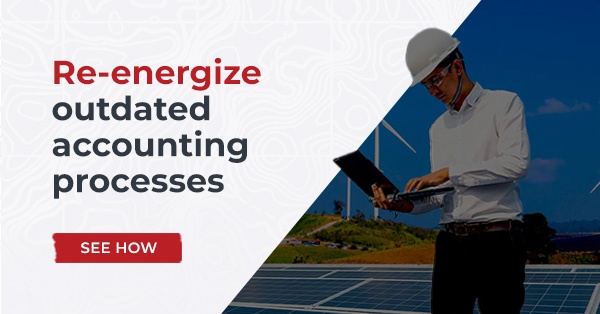Accounting for special purpose entities: what you need to know

While there are any number of inspirational quotes about the value of taking risks, once a business has achieved a certain level of success – hired employees, secured investors and shareholders, made agreements with suppliers and customers – a bold move that doesn't pan out can have far-reaching effects.
Then again, not taking risks might mean being left behind, especially in a sector like renewable energy, where new innovations come to market every day.
A special purpose entity (SPE), also known as a special purpose vehicle (SPV), is a way for businesses to take advantage of innovations and opportunities without putting everything they've worked for on the line. We'll discuss the use cases and accounting considerations for SPEs, specifically in the renewable energy sector.
What are special purpose entities?
In the simplest terms, a special purpose entity, also known as a special purpose vehicle, is exactly what it sounds like: a legal entity created to carry out a specific mission. SPEs can take different forms, such as LLCs, limited partnerships, or trusts. There are several reasons why a renewable energy business might set up an SPE.
Isolating financial risk
Special purpose entities can encourage innovation, giving some companies greater confidence to take risks while having assurances they won't lose everything if the initiative doesn’t go as planned.
If a business wants to finance a major project — say, the construction of a green hydrogen fuel cell system — it can create a special purpose entity solely to house that project. This protects the parent company from having to declare bankruptcy even if that financial asset fails. An SPE can also serve as a way to securitize debt in order to raise capital.
Tax purposes
PwC noted that "to increase tax efficiency, some operators use structures called conduits in which they have SPEs own power generating equipment so that the operator does not bear tax liability."
The parent company can then enter an operating lease with the SPE, called a synthetic lease. The parent company has use of the equipment and can expense the lease cost while recording the tax liability on the SPE's balance sheet.
Investopedia noted that the synthetic lease had lost popularity but is making a comeback among companies able to navigate the associated regulations.
Enron: the 'special purpose' of their special purpose entities was fraud
It’s important to remember that unethical business leaders have used SPE for nefarious purposes in the past. Most notorious among them is Enron, the energy company that catapulted the oxymoron "creative accounting" into the cultural lexicon in the early 2000s. In a 2002 article in the Journal of Accountancy, C. William Thomas described how Enron used loopholes in the rules governing SPEs to essentially hide debt, inflate return on assets (ROA), and even pay its own CFO $30 million in "management fees."
"As its financial dealings became more complicated, the company apparently also used SPEs to 'park' troubled assets that were falling in value, such as certain overseas energy facilities," Thomas wrote. "Transferring these assets to SPEs meant their losses would be kept off Enron’s books."
Eventually, the company's stock spiraled downward, multiple top executives went to prison, and Enron was cemented in history as a poster child for corporate villainy.
Regulators determined not to let history repeat itself
One reason Enron was able to fly under the radar for as long as it did is because Financial Accounting Standards Board (FASB) guidelines at the time allowed companies to avoid considering an SPE as a subsidiary and avoid listing the SPE's debts on their own financial statements — as long as a mere 3% of the entity was owned by an outside interest and the parent enterprise didn't hold a majority voting interest.
"Without majority voting interest, a firm was not required to consolidate the SPE even if it was the primary beneficiary of the SPE's activities," said a 2003 article in the Graziadio Business Review.
After the Enron debacle, regulators worked to close this loophole, with the FASB adopting Financial Accounting Interpretation (FIN) 46 effective Jan. 31, 2003. The measure increased the "outside interest" requirement to 10% and required consolidation on financial statements not just for voting interest entities (VOEs) but for variable interest entities (VIEs), in which the reporting enterprise benefits from residual returns and covers expected losses of the entity but doesn't necessarily have a majority voting interest.
With the addition of the VIE to the guidance, many more SPEs met the requirement for consolidation, making it more difficult for companies to use SPEs to hide unpalatable financial information.
How has the SPE accounting landscape evolved?
The principle behind the SPE accounting guidelines is the same as it was in 2003: to ensure more transparency in financial reporting. The finer details of the rules have evolved over the last 20 years, however.
The accounting standard governing consolidation is now known as ASC 810. In 2016, in response to complaints that the guidance was too complex, the FASB undertook efforts to reorganize it. The board ultimately tabled those efforts in 2022, deciding to focus on the possibility of creating a single consolidation model for business entities instead of the current VIE/VOE models.
Much of the guidance surrounding consolidation requirements pertains to whether an entity meets the criteria for consolidation and whether it should be considered a VIE or a VOE. Fortunately, that's fairly straightforward when it comes to special purpose entities. PwC notes that "the VIE model typically applies to entities that are formed for a predefined limited purpose, such as securitizations and asset-backed financing entities because these entities normally meet the definition of a VIE."
There's also guidance surrounding consolidation when a VIE isn't a business.
Gravity Software simplifies special purpose entity accounting
Accounting for special purpose entities is complicated enough without having to worry about whether your software will be up to the task.
Gravity Software was designed especially for multi-entity accounting, so you can easily manage finances for your parent company and its special purpose entities with a single login.
Rather than needing to duplicate shared expenses multiple times and risk the possibility of manual errors or omissions, you can simply select the SPEs to which you want to apply those expenses.
You can create your own personalized workflows to manage approvals for certain types of expenses using Microsoft Power Automate.
You can also create consolidated financial reports without needing to copy and paste each line item. In fact, compiling consolidated financial statements is easier than ever with Jet Reports, Gravity's newest integration.
When you're finished compiling reports, you can use Gravity's integration with Microsoft Power BI to turn them into stunning data visualizations.
See what else your renewable energy company can do with Gravity. Schedule a demo today.
Gravity Software
Better. Smarter. Accounting.


